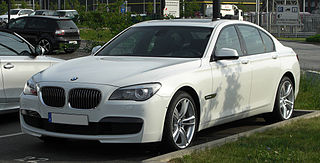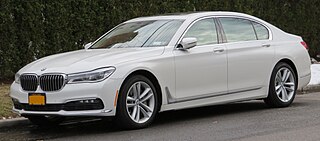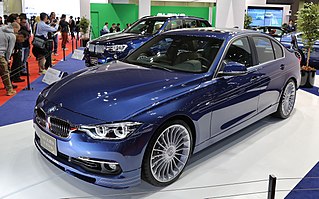
The BMW E39 is the fourth generation of the BMW 5 Series range of executive cars, which was manufactured from 1995 to 2004. It was launched in the saloon body style, with the station wagon body style introduced in 1996. The E39 was replaced by the E60 5 Series in 2003, however E39 Touring models remained in production until May 2004.

The fourth generation of the BMW 7 Series consists of the BMW E65 and BMW E66 luxury cars. The E65/E66 was produced from 2001 to 2008 and is often collectively referred to as the E65. The E65 replaced the E38 7 Series and was produced with petrol and turbo-diesel straight-six and V8 engines, along with a petrol V12 flagship model.

The BMW N62 is a naturally aspirated V8 petrol engine which was used in BMW cars from 2001 to 2010. It also remained in small-scale production for the Morgan Aero until 2019. The N62 is the world's first engine to use a continuously variable-length intake manifold, and BMW's first V8 to feature variable valve lift.

The Audi S4 is the high performance variant of Audi's compact executive car A4. The original Audi S4, built from 1991 until 1994, was a performance-oriented version of Audi's 100 saloon/sedan. All subsequent S4s since 1997 have been based on the Audi A4; and as the A4 has evolved from one generation to the next, so has the S4.

Alpina Burkard Bovensiepen GmbH & Co. KG is an automobile manufacturing company based in Buchloe, in the Ostallgäu district of Bavaria, Germany that develops and sells high-performance versions of BMW cars. Alpina works closely with BMW and their processes are integrated into BMW's production lines, and is recognized by the German Ministry of Transport as an automobile manufacturer, in contrast to other performance specialists, which are aftermarket tuners. The Alpina B7 is produced at the same assembly line in Dingolfing, Germany, as BMW's own 7 Series. The B7's twin-turbo 4.4-litre V8 is assembled by hand at Alpina's facility in Buchloe, Germany, before being shipped to BMW for installation, and the assembled vehicle is then sent back to Alpina for finishing touches.

The fifth generation of the BMW 7 Series consists of the BMW F01 and BMW F02 full-size luxury sedans. The F01/F02 generation was produced by BMW from 2008 to 2015 and is often collectively referred to as the F01.

The BMW M2 is a high-performance version of the BMW 2 Series automobile developed by BMW's motorsport division, BMW M GmbH. As the 2 Series replaced the 1 Series coupé and convertible models, the first-generation M2 was marketed as the most basic M model in the range.

The sixth generation of the BMW 7 Series consists of the BMW G11 and BMW G12 luxury saloons. The G11/G12 generation was produced by BMW from 2015 to 2022, and is often collectively referred to as the G11.

The Alpina B4 and Alpina D4 are high-performance compact executive cars manufactured by the German automobile manufacturer, Alpina. Based on the BMW 4 Series, the B4 and D4 are manufactured in coupé and convertible body styles. The first generation B4 and D4 were launched in 2014 and the more powerful B4 S was launched in 2017.

The Alpina B3 (F30/F31) and Alpina D3 (F30/F31) are high performance compact executive cars manufactured by German automobile manufacturer, Alpina. Based on the BMW 3 Series (F30), the B3 is available in saloon and wagon body styles. The car was officially launched at the 2013 Geneva Motor Show.

The Alpina B3 (E90) and Alpina D3 (E90) are a series of high performance compact executive cars manufactured by German automobile manufacturer Alpina from 2007 to 2013. Based on the BMW 3 Series (E90), the B3 and D3 were available in coupé, saloon, convertible and station wagon body styles. The B3 was officially unveiled at the 2007 Geneva Motor Show.

The Alpina B6 (E63) is the second generation of the high performance grand tourer manufactured by German automobile manufacturer Alpina from 2005 to 2010. Based on the BMW 6 Series (E63), the car was available in coupé and convertible bodystyles. The B6 was introduced in 2005.

The Alpina B6 (F12) is the third generation of the high performance grand tourer manufactured by German automobile manufacturer Alpina. Introduced at the 2011 Tokyo Motor Show, the B6 was based on the BMW 6 Series and was available in coupé and convertible body styles, with the latter being introduced at the 2011 Frankfurt Motor Show. A third saloon bodystyle called the gran coupé was introduced in 2014. The Alpina B6 gran coupé was replaced by the Alpina B8 gran coupe (G16) in 2021.

The Alpina Roadster S is a sports car manufactured by the German automobile manufacturer Alpina from 2003 to 2007. Based on the BMW Z4 (E85), the Roadster S was unveiled at the 2003 Frankfurt Motor Show.

The Alpina B7 (F01) is the fourth generation of the high-performance BMW 7 Series manufactured by Alpina from 2011 until 2015. Based on the BMW 7 Series (F01), the car was introduced to the public at the 2010 Chicago Auto Show and was available in normal and long-wheelbase versions, with xDrive or rear-wheel drive. The B7's engine was hand-built at the Alpina factory at Buchloe and then sent to the BMW factory in Dingolfing to be put into the body shell. The car was painted and initially assembled at the Dingolfing plant and was then sent back to Alpina for final assembly. It was the second Alpina B7 to be offered in North America, with 1,740 examples imported and sold in the United States.

The Alpina B7 Bi-Turbo, or Alpina B7, is the fifth generation of the high-performance full-size luxury car manufactured by German automobile manufacturer Alpina. Based on the BMW 7 Series (G12), the B7 Bi-Turbo was introduced at the 2016 Geneva Motor Show. Known as the B7 in North America, the car is the third B7 model to be imported to the United States. The Alpina B7 was discontinued in September 2022.

The Alpina B5 (E60) is the first generation of the Alpina B5 high performance executive car manufactured by German automobile manufacturer Alpina from 2005 to 2011. Based on the BMW 5 Series (E60), the car was available in saloon and wagon bodystyles. The car succeeds the Alpina B10.

The Alpina B5 and D5 (F10) are a series of high performance executive cars manufactured by German automobile manufacturer Alpina from 2011 to 2016. Introduced at the 2010 Goodwood Festival of Speed, the car is the second generation of the B5 and succeeds the B5 (E60). Based on the BMW 5 Series (F10), the car was available in saloon and wagon bodystyles.

The Alpina B12 is a name given to high-performance luxury automobiles manufactured by German automobile manufacturer Alpina. The B12 originally succeeded the B11 4.0 in 1988 which was based on the BMW 7 Series (E32) and was also based on the same car. Subsequent models were based on the BMW 7 Series (E38) and the BMW 8 Series (E31). Production ended in 2001 when the 7 Series (E38) models were discontinued. The B12 was replaced by the B7 (E65) and the B6 (E63).

The Alpina B5 and D5 (G30) are a series of high performance executive cars manufactured by German Automobile manufacturer Alpina. Introduced at the 2017 Geneva Motor Show, the car is the third generation of the B5 and succeeds the Alpina B5 (F10). Based on the BMW 5 Series (G30), the car is available in both saloon and wagon bodystyles.























